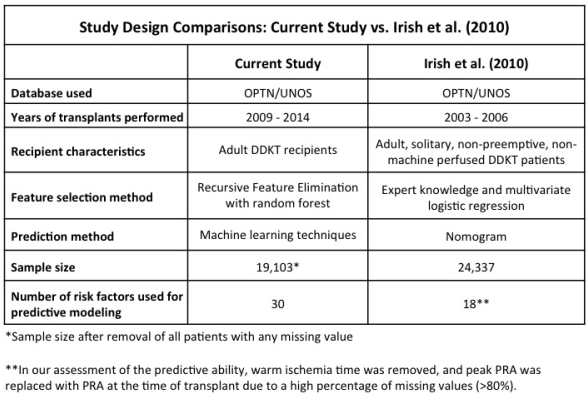A Machine Learning Approach for Prediction of Delayed Graft Function in Deceased Donor Kidney Transplant Recipients
1Terasaki Research Institute, Los Angeles, CA
2Division of Nephrology, David Geffen School of Medicine at UCLA, Los Angeles, CA.
Meeting: 2018 American Transplant Congress
Abstract number: C53
Keywords: Cadaveric organs, Graft function, Kidney transplantation, Prediction models
Session Information
Session Name: Poster Session C: Kidney Donor Selection / Management Issues
Session Type: Poster Session
Date: Monday, June 4, 2018
Session Time: 6:00pm-7:00pm
 Presentation Time: 6:00pm-7:00pm
Presentation Time: 6:00pm-7:00pm
Location: Hall 4EF
Introduction:
Delayed graft function (DGF) is an early signal of graft injury that is common in deceased donor kidney transplant (DDKT) recipients. Although we have predictive models for DGF available (Jeldres 2009, Irish 2010, Chapal 2014), machine learning (ML) techniques allow for a more comprehensive approach for predictive modeling compared to the traditional approach. Therefore, in the current study, we assessed a ML-based approach to predicting DGF.
Methods:
We employed six ML algorithms for prediction: logistic regression, elastic net, support vector machine with linear basis function and radial basis function kernels, random forest, and artificial neural network. OPTN/UNOS data on adult DDKT received between 2009 and 2014 (n=19,103) were used. The top 30 out of 107 variables were selected via random forest. We then developed six ML models with the newly selected variables and six control ML models with 17 risk factors identified by Irish et al. (2010). Predictive performances were assessed based on area under curve (AUC), specificity, and sensitivity. Optimal, model-specific thresholds were computed by Youden's J statistics. 
Results:
The new set of parameters exhibited higher mean AUC (0.759 vs. 0.721), higher mean sensitivity (0.753 vs. 0.696) and higher mean specificity (0.638 vs. 0.629) compared to controls. Among the ML models developed with the new variables, artificial neural network had the highest AUC of 0.760. 
Conclusion:
Variable selection via a random forest-based method and a subsequent prediction with artificial neural network outperformed the standard approach (AUC=0.724) in this sample, possibly leading to more accurate identification of patients at higher risk of developing DGF in clinical settings.
CITATION INFORMATION: Kawakita S., Waterman A., Everly M. A Machine Learning Approach for Prediction of Delayed Graft Function in Deceased Donor Kidney Transplant Recipients Am J Transplant. 2017;17 (suppl 3).
To cite this abstract in AMA style:
Kawakita S, Waterman A, Everly M. A Machine Learning Approach for Prediction of Delayed Graft Function in Deceased Donor Kidney Transplant Recipients [abstract]. https://atcmeetingabstracts.com/abstract/a-machine-learning-approach-for-prediction-of-delayed-graft-function-in-deceased-donor-kidney-transplant-recipients/. Accessed December 28, 2025.« Back to 2018 American Transplant Congress
